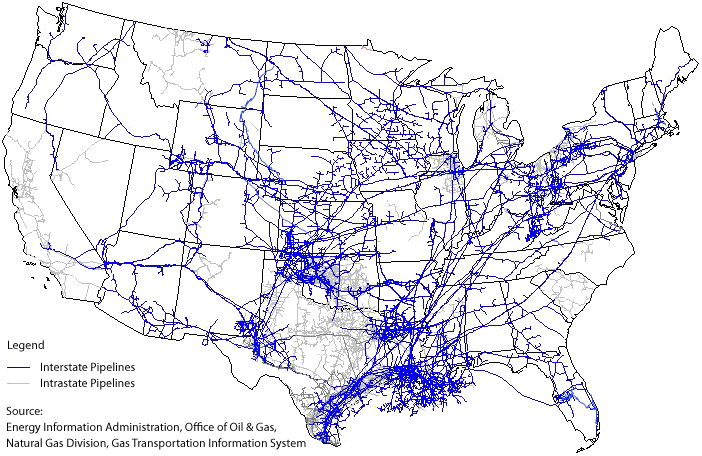Based on petroleum supply estimates from the Energy Information Administration, oil and petroleum products consumed in the United States totaled 7.284 billion barrels in 2017, and increase of 1% from 2016. Petroleum used for electrical generation accounted for 0.5 percent of that total. The remainder of the consumption included transportation (70.3 percent), industrial (24.2 percent), and residential and commercial (5.0 percent) (Statistica.com).

The Energy Information Administration records show total natural gas consumption in 2017 totaled 27,110,271 million cubic feet. Of that total, 24,824,283 million cubic feet was delivered to the final consumer. Consumption used for electrical generation accounted for 9,250,066 million cubic feet or 37.2 percent of this total, residential use consumed 17.6 percent and industrial use consumed 32.0 percent. The remainder of the total (13.2 percent) was used for commercial and vehicle purposes (EIA: Natural Gas Consumption by End-Use).
Similar to the electric transmission grid, the current oil and natural gas transmission infrastructure was not designed to meet the expected rate of natural gas consumption growth that the nation will see in the next decade. More than 90 percent of all planned new power generation in the United States will be fueled by natural gas. Almost all small, supplemental back-up generating units (such as those used by hospitals and schools) are powered by natural gas.
According to a report of recommendations prepared by the National Association of Regulatory Utility Commissioners (NARUC), one of the key challenges to energy availability is an adequate natural gas pipeline and distribution system to provide an ever-increasing gas demand across the country. The National Petroleum Council (NPC) estimates over 38,000 miles of new transmission lines will be needed, as well as 263,000 miles of new distribution lines. That much pipeline will require the attention of every state, and many regulatory bodies within the states. It will also require the attention of the Federal Energy Regulatory Commission (FERC), the Bureau of Land Management (BLM), the U.S. Forest Service, and many other federal entities.
The efficient and effective movement of natural gas from producing regions to consumers requires an extensive transmission system. In many instances, natural gas produced from a particular well will have to travel a great distance to reach its point of use. The transmission system for natural gas consists of a complex network of pipelines, pumping stations, and storage facilities. The transmission of natural gas is closely linked to its storage. When natural gas demand is low, it can be put into storage facilities until needed.
Natural gas pipelines include pipelines used in the gathering system, and in interstate transmission and final distribution. The gathering system consists of low-pressure, low-diameter pipelines that transport raw natural gas from the wellhead to the processing plant.
Pipelines can be characterized as interstate or intrastate. Interstate pipelines carry natural gas across state boundaries, in some cases, across the country. Intrastate pipelines, on the other hand, transport natural gas within a particular state. We will focus on the fundamentals of interstate natural gas pipelines, because the technical and operational details discussed are essentially the same for intrastate pipelines.
Natural gas pipelines are subject to regulatory oversight, which in many ways determines the manner in which pipeline companies must operate.
Want to learn more?
See the following sites to learn more about the
Interstate pipelines are the 'highways' of natural gas transmission. Natural gas that is transported through interstate pipelines travels at high pressure in the pipeline, at pressures anywhere from 200 to 1500 pounds per square inch (psi). This reduces the volume of the natural gas being transported (by up to 600 times), as well as providing propellant force to move the natural gas through the pipeline. For more information on interstate pipelines in general, visit the website of the Interstate Natural Gas Association of America.
The Federal Energy Regulatory Commission (FERC) and other Federal agencies are encouraging and sometimes requiring interstate natural gas pipeline operators to use existing rights-of-way (ROW), where possible when proposing routes for new construction. This is occurring throughout the country, even in more rural, sparsely populated areas.
